|
Author
|
Topic: Apollo 13: Spacecraft damage imagery
|
rgarner
Member Posts: 1225
From: Shepperton, United Kingdom
Registered: Mar 2012
|
 posted 08-31-2015 01:23 PM
posted 08-31-2015 01:23 PM
   
I have been perusing through NASA's archive but can't find any detailed images of the damaged caused by the explosion on Apollo 13. Are there any decent quality images anyone is aware of? I am trying to replicate the effect. |
18blue78
Member Posts: 132
From: UK
Registered: Aug 2013
|
 posted 08-31-2015 02:40 PM
posted 08-31-2015 02:40 PM
  
You've probably already seen these but; |
rgarner
Member Posts: 1225
From: Shepperton, United Kingdom
Registered: Mar 2012
|
 posted 08-31-2015 04:46 PM
posted 08-31-2015 04:46 PM
   
Thank you for these, but yes I have seen them. I can't see enough detail here to replicate it correctly. |
Headshot
Member Posts: 891
From: Vancouver, WA, USA
Registered: Feb 2012
|
 posted 08-31-2015 06:17 PM
posted 08-31-2015 06:17 PM
   
I recall, years ago, reading about some individual or group who were going to use a CAD rendering of the SM bay along with digital versions of these images to generate a detailed 3-D view of the damaged SM. If anything ever came of it, I never saw it.I also remember reading, at the time, that NASA was going to use computers to "clean up and sharpen" these images, but I never saw any results published in Aviation Week, my source in those pre-internet days. |
Space Cadet Carl
Member Posts: 225
From: Lake Orion, Michigan
Registered: Feb 2006
|
 posted 09-01-2015 11:03 AM
posted 09-01-2015 11:03 AM
   
That service module separation was done with the LM still attached... a very strange sight if anyone would have been in a position to see it. And I don't believe the crew had more than a minute or two to take photos of the damage from a poor angle out their windows either. |
rgarner
Member Posts: 1225
From: Shepperton, United Kingdom
Registered: Mar 2012
|
 posted 09-01-2015 01:30 PM
posted 09-01-2015 01:30 PM
   
I expected as much but had hoped there was a decent photo. I may have to settle for second best here, does anyone have a photograph of the tanks exposed? At least if I can see how they look in tact I can replicate an explosion effect. |
Headshot
Member Posts: 891
From: Vancouver, WA, USA
Registered: Feb 2012
|
 posted 09-01-2015 03:37 PM
posted 09-01-2015 03:37 PM
   
There is a nice clean diagram and two excellent images on page 253 of Apollo Expeditions to the Moon (NASA SP-350) edited by E.M. Cortright. |
rlobinske
Member Posts: 155
From: Crawfordville, FL
Registered: Oct 2014
|
 posted 09-02-2015 02:50 PM
posted 09-02-2015 02:50 PM
  
This page has a good photo of the fuel cells.Hydrogen and oxygen tanks: SP-350 |
rgarner
Member Posts: 1225
From: Shepperton, United Kingdom
Registered: Mar 2012
|
 posted 09-02-2015 03:56 PM
posted 09-02-2015 03:56 PM
   
Thanks rlobinske, I have seen this image. It still doesn't give me the ''overall look'' or ''feel'' of the destruction. If I am going to recreate it, I think I need to at least be partly accurate.And thanks Headshot, I'm looking for a copy now - hopefully the images are clear enough for me to use! |
rgarner
Member Posts: 1225
From: Shepperton, United Kingdom
Registered: Mar 2012
|
 posted 09-04-2015 07:37 AM
posted 09-04-2015 07:37 AM
   
Hi Headshot. I bought the book but there is nothing on those pages about Apollo 13. I checked the Apollo 13 sections but there wasn't much on it, certainly no diagrams of note.Anyone else got any suggestions? |
rlobinske
Member Posts: 155
From: Crawfordville, FL
Registered: Oct 2014
|
 posted 09-07-2015 12:42 PM
posted 09-07-2015 12:42 PM
  
There just are not any clearer photos of the damage. What most model builders have done is to work from the intact equipment images and make their best guesses. |
sev8n
Member Posts: 236
From: Dallas TX USA
Registered: Jul 2012
|
 posted 09-07-2015 01:31 PM
posted 09-07-2015 01:31 PM
  
The Cosmosphere has a large-scale model of the damaged SM displayed next to the Apollo 13 CM, found this photo. |
Headshot
Member Posts: 891
From: Vancouver, WA, USA
Registered: Feb 2012
|
 posted 09-07-2015 06:16 PM
posted 09-07-2015 06:16 PM
   
Did the tank explosion and subsequent rupture/ejection of the SM's panel permanently knock out the SM high gain antenna? |
Andy Anderson
Member Posts: 87
From: Perth, Australia
Registered: Dec 2009
|
 posted 09-07-2015 10:52 PM
posted 09-07-2015 10:52 PM
   
As rlobinske says, there were never any clear images of the CSM after separation.This quote from the Apollo 13 Cryogenic Oxygen Tank 2 Anomaly Report 1 (MSC-02545) states the problem. The average distance from the Hasselblad cameras to the service module for the onboard photography was about 410 feet for magazine R and about 880 feet for magazine N, resulting in an image scale of 1:1500 and 1:1077, respectively. Of the frames showing the service module, orientation was such that the majority do not show bay 4, and at no time are the sun angle and camera view simultaneously directed into bay 4. In an effort to draw detail out of the high density in the area of the normal location of the cryogenic oxygen tank 2 in bay 4, two black and white frames (AS13-59-8500 and -8501) and three color frames (AS13-58-8462, -8464, and -8465) were subjected to photographic processing enhancement for specific details. These same frames were also subjected to electronic scanning with an image digital construction technique similar to that used on the Surveyor lunar surface photography. Assisting the Photographic Technology Laboratory at the Manned Spacecraft Center were the Jet Propulsion Laboratory, McDonnell-Douglas Corporation, LogEtronics Incorporated, Ciba Corporation, and Data Corporation with their specialized techniques, facilities, and experienced personnel. After exhausting all means of enhancement from the masters, the original film was taken to Data Corporation, Dayton, Ohio, to be scanned with their high-intensity, 1-micron probe and digitally reconstructed to bring out the detail for analysis. Here are a couple of those images as originally shot to illustrate how far away and indistinct the view was.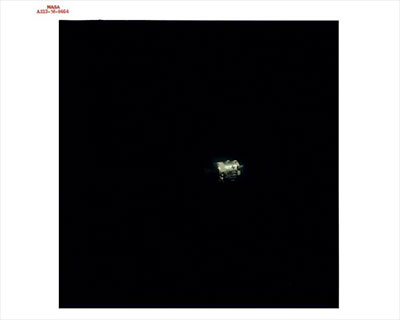 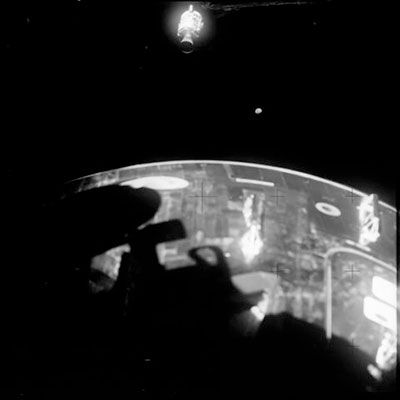
The investigation team also tried to "reverse engineer" the images by constructing a model and arranging the interior in such a way that when a photo was taken using similar lighting and effects displayed in the original image, as shown below, a comparison could be made to see how well the original and the "constructed" image compared. If they were similar it could be deduced that the model represented the actual condition of the service module after the failure.
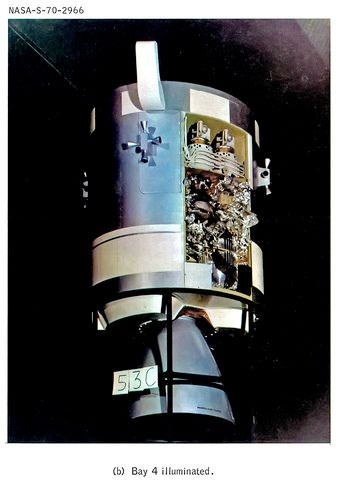 |
LM-12
Member Posts: 3324
From: Ontario, Canada
Registered: Oct 2010
|
 posted 09-08-2015 04:28 AM
posted 09-08-2015 04:28 AM
  
quote:
Originally posted by Headshot:
Did the tank explosion and subsequent rupture/ejection of the SM's panel permanently knock out the SM high gain antenna?
The service module high-gain antenna can be seen in the top-left corner of photo AS13-59-8508. |
Space Cadet Carl
Member Posts: 225
From: Lake Orion, Michigan
Registered: Feb 2006
|
 posted 09-08-2015 08:23 AM
posted 09-08-2015 08:23 AM
   
Andy, thanks for posting those great shots. I never knew the crew was inside LM Aquarius snapping those photos until I saw photo AS13 59 8501. And in spite of them being inside the LM, the crew STILL couldn't obtain a decent shot of the service module from less than several hundred feet away. They probably had to wait for the SM to rotate, which didn't happen until it had drifted far off. |
Andy Anderson
Member Posts: 87
From: Perth, Australia
Registered: Dec 2009
|
 posted 09-08-2015 09:54 PM
posted 09-08-2015 09:54 PM
   
Carl, it apparently took a little while for the SM to come into view after sep. From the Apollo 13 Mission Report, page 8-16, the crew stated, The service module first appeared in the docking window at a distance of about 80 feet. The entire bay 4 outer panel was missing, and torn Mylar insulation was seen protruding from the bay. Because of the brilliant reflections from the Mylar, it was difficult to see or photograph any details inside the bay. Initial photography of the service module was conducted through the docking window using the command module 70-mm camera and an 80-mm lens. This camera, the 16-mm sequence camera with a 75-mm lens, and the command module electric still camera with a 250-mm lens were then operated while viewing through the right-hand window. Camera settings were made according to ground instructions. No magazine designation was made by the ground for the sequence camera, so the surface color film was used. This is, I believe the first picture taken of the service module after separation;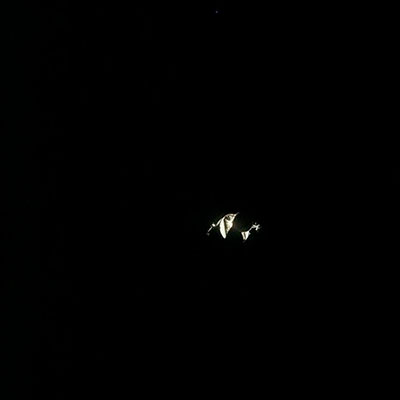 ...using the color magazine and then from the B&W magazine, AS13-59-8501 was the second image from that camera. By the way, as has been mentioned before, you can view/download the 70mm Hasselblad images for Apollo 13 here, or for any of the other missions as well. |
rgarner
Member Posts: 1225
From: Shepperton, United Kingdom
Registered: Mar 2012
|
 posted 09-09-2015 03:18 AM
posted 09-09-2015 03:18 AM
   
Andy, thank you very much for these images, the recreation is precisely what I need. Though the first two images show up as being deleted so I can't get a closer look sadly. |
Robert Pearlman
Editor Posts: 43576
From: Houston, TX
Registered: Nov 1999
|
 posted 10-03-2015 11:23 AM
posted 10-03-2015 11:23 AM
   
You can now find the full resolution, unedited scans of the service module here. The release inspired planetary scientist Alex Parker to assemble an animation. |
dwager
Member Posts: 63
From: Augusta, GA
Registered: Sep 2014
|
 posted 10-06-2015 07:34 AM
posted 10-06-2015 07:34 AM
   
Thank you, all, for this conversation thread - much of the information and links all of you shared was/were new. I now have other places to explore!! |
LM-12
Member Posts: 3324
From: Ontario, Canada
Registered: Oct 2010
|
 posted 10-06-2015 08:38 AM
posted 10-06-2015 08:38 AM
  
Regarding the animation, and looking at the frame numbers, didn't the SM spin in the opposite direction? |
RichieB16
Member Posts: 582
From: Oregon
Registered: Feb 2003
|
 posted 03-03-2019 01:21 PM
posted 03-03-2019 01:21 PM
   
Can someone help me track down the clearest damage photo of the Apollo 13 SM? I want to use one for my custom card project, but I can't seem to find a photo I really like. I'm having a difficult time finding sharp high res images. Color or B&W is fine. Thanks.Editor's note: Threads merged. |
MadSci
Member Posts: 230
From: Maryland, USA
Registered: Oct 2008
|
 posted 03-21-2019 06:53 PM
posted 03-21-2019 06:53 PM
  
The comments by the astronauts during at the time included descriptions of a large amount of damage to the engine "bell". I have never been able to see it on any of the high resolution photographs. Does anyone have any insights as to whether the descriptions occurred at a time when the astronauts were observing but not photographing and so saw something that didn't appear on the later photos or was it just a mistake in the moment?It seems unlikely to me that there would be damage to the engine bell that would not be located in line with the damaged panels, as about the only way to damage the engine bell would be to have a panel let go initially on three sides with the side nearest the bell acting as a 'hinge' so that the panel rotated over it and the panel hit the bell and then the remaining connection to the SM was broken and the panel flew off. |
Andy Anderson
Member Posts: 87
From: Perth, Australia
Registered: Dec 2009
|
 posted 03-21-2019 10:43 PM
posted 03-21-2019 10:43 PM
   
I don't believe there actually was any identified damage to the nozzle.After service module sep, at GET 138 05,the following exchanges occurred between Fred and Joe, LMP - Yes,it looks like it got to the SPS bell, too, HoustonCC - Think it zinged the SPS engine bell, huh? LMP - That's the way it looks; unless that's just a dark brown streak. It's really a mess. ... LMP - Okay, Joe, I'm looking down the SPS bell, and it looks - looks okay on the inside; maybe just a streak. Later examination of the photographs led to this determination in the Apollo 13 Review Board Report - Chapter 5 page 5-8 (3); Combustion or vaporization of the Mylar or Kapton might account for the discoloration of the SM engine nozzle as onserved and photographed by the crew The following image — which is from the team who did enhancements of the images — and a graphic from the investigation show the observed "stain." 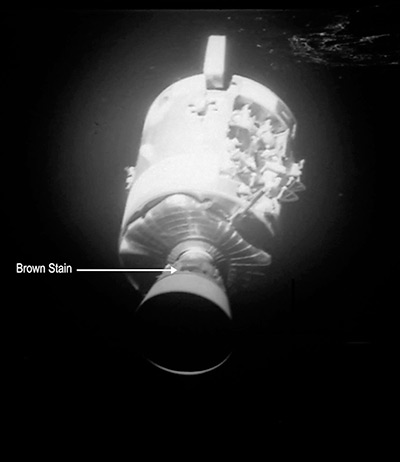 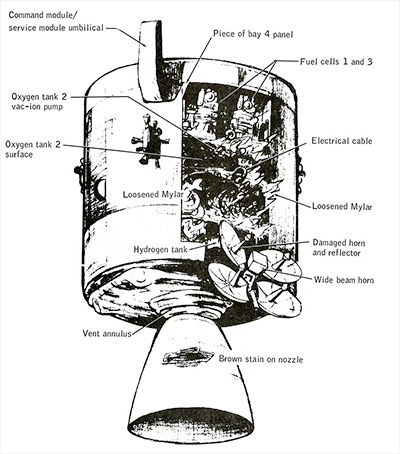
|
LM-12
Member Posts: 3324
From: Ontario, Canada
Registered: Oct 2010
|
 posted 03-21-2019 11:08 PM
posted 03-21-2019 11:08 PM
  
Could a 3-D anaglyph be made using photos taken of the damaged service module, perhaps revealing more details?Using frames 8500 and 8501, or frames 8464 and 8465, for example. |
Andy Anderson
Member Posts: 87
From: Perth, Australia
Registered: Dec 2009
|
 posted 03-22-2019 12:28 AM
posted 03-22-2019 12:28 AM
   
I am sure current technology could add to the enhancement of the Apollo 13 images - if it has already been done, it would be great to see the results.To give an idea of what was done in 1970, I extracted from my files a few documents and images which can be found here. |
LM-12
Member Posts: 3324
From: Ontario, Canada
Registered: Oct 2010
|
 posted 03-22-2019 07:09 AM
posted 03-22-2019 07:09 AM
  
Thank you for providing those relevant documents. I see that stereoscopic photography is mentioned in the McDonnell Douglas letter.It would be interesting to see stereo images of the service module from the high-resolution Apollo photos that have been made available in recent years.
|
Robert Pearlman
Editor Posts: 43576
From: Houston, TX
Registered: Nov 1999
|
 posted 03-22-2019 07:29 AM
posted 03-22-2019 07:29 AM
   
Two stereoscopic images of the service module damage are included in David Eicher and Brian May's book "Mission Moon 3D." |
LM-12
Member Posts: 3324
From: Ontario, Canada
Registered: Oct 2010
|
 posted 01-18-2020 02:28 AM
posted 01-18-2020 02:28 AM
  
16mm Magazine FF has a few very brief glimpses of the service module after separation. The Apollo Flight Journal has the film: - the SM can be seen at 0:40
- the damaged Bay 4 can be seen at 1:05
It looks to me like the frames at 1:05 might be the closest view of the Bay 4 damage from the CM/LM. |

















